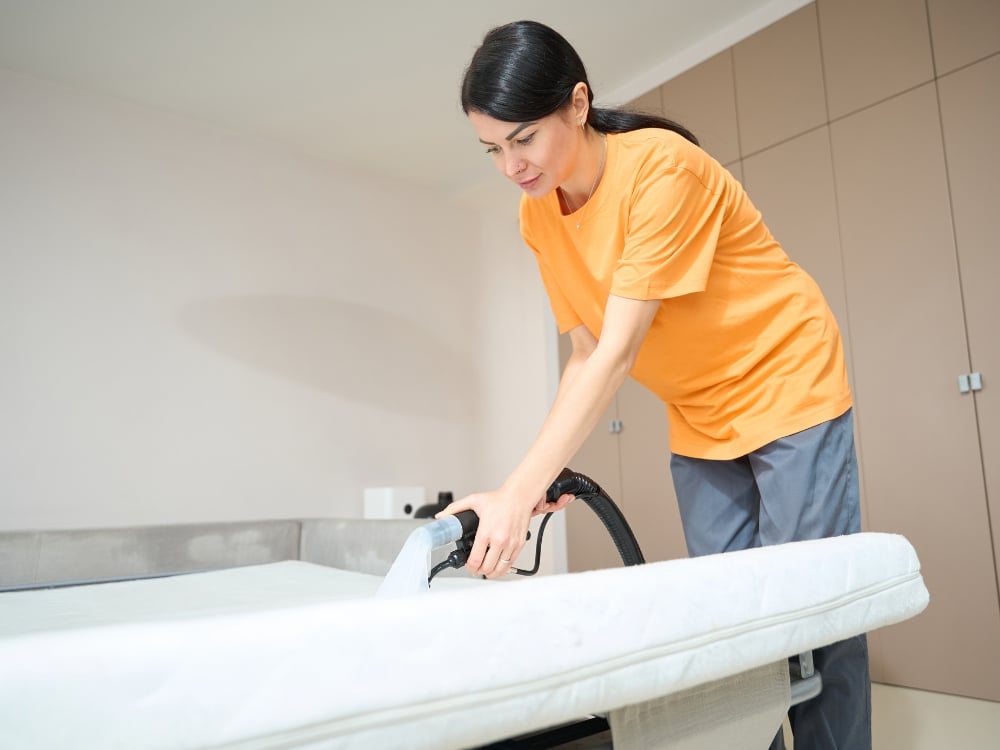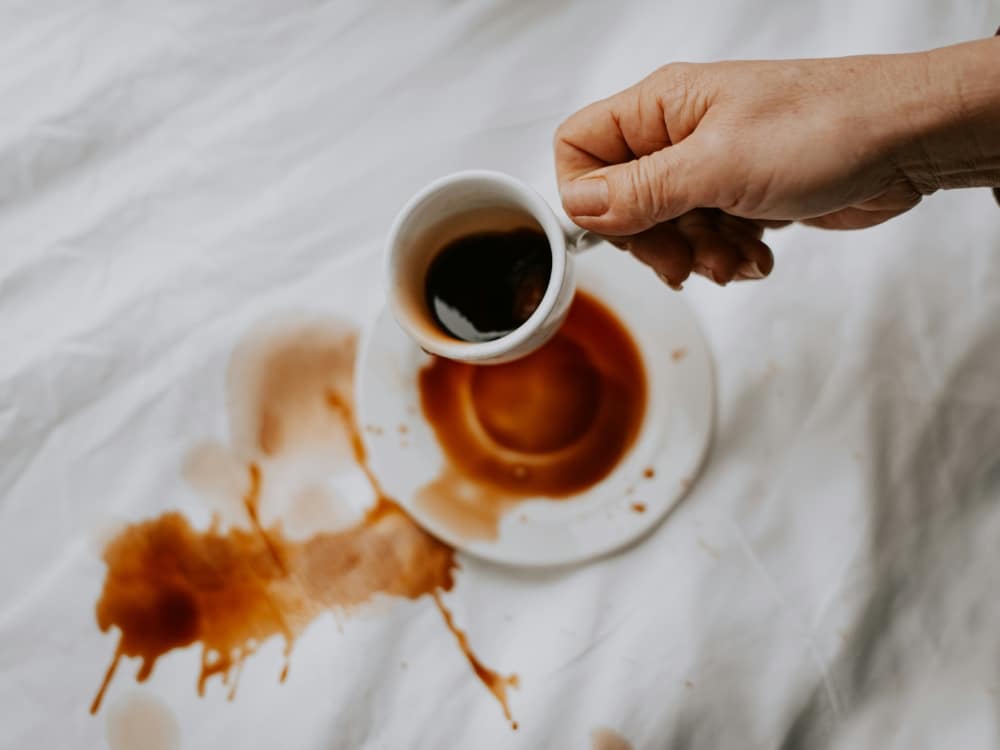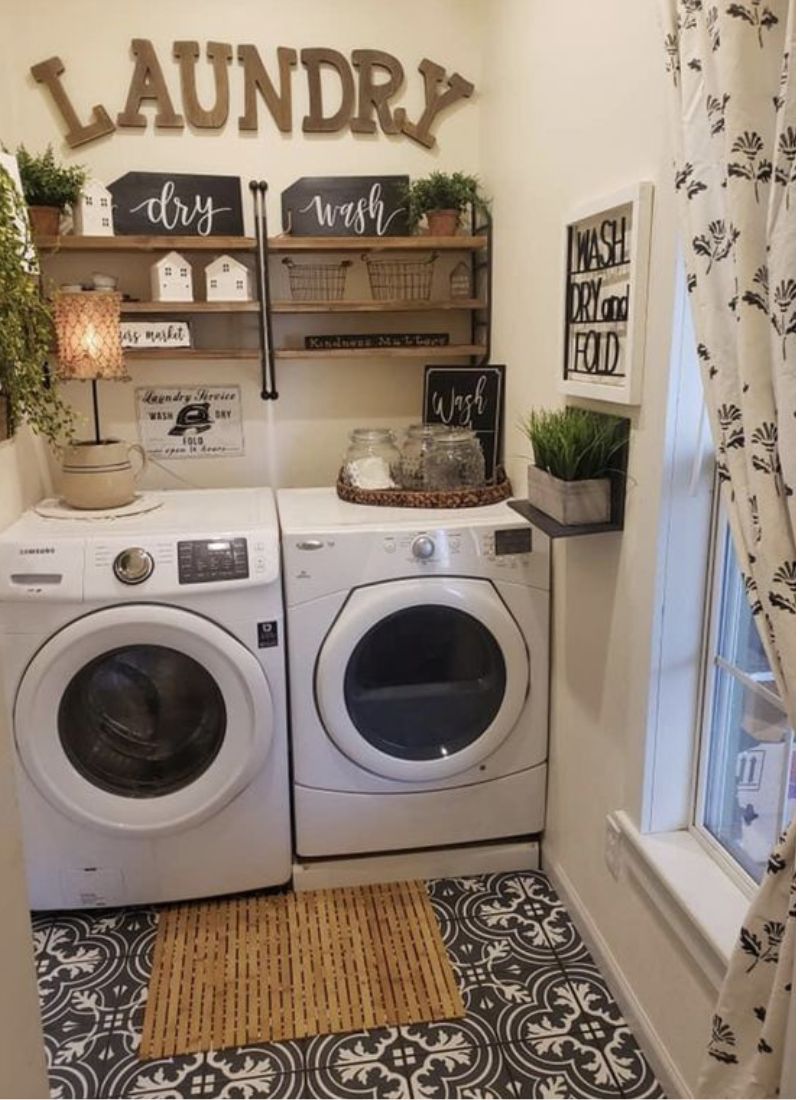Hey all! My name is Julia, former college student and a home decor enthusiast who loves DIY home improvement projects and finding creative ways to decorate any living spaces on a budget. Recently moved from my dorm to my new apartment which I renovated from scratch and I am here to help you with tips & tricks about home decor/college and more 🙂
Not sure how to clean your mattress? Don’t worry—it’s easier than you think! With just a few simple steps, you can get rid of dust, stains, and odors, and make your bed feel fresh and comfy again.

Let’s talk about something nobody really loves to do but everybody has to—how to clean mattress at home.
I put it off too, but honestly, it’s not that bad once you get the hang of a few easy mattress cleaning tips.
With a vacuum, baking soda, and a little patience, you can ditch those weird smells and mystery stains. Your bed will feel next-level fresh.
The best way to clean mattress is to strip your bed, vacuum the mattress top and sides, sprinkle on some baking soda, let it chill for a few hours, and then vacuum it up again. You can spot clean mattress stains with a little hydrogen peroxide or mild detergent.
If you’re into it, a few drops of essential oil can add that just-washed vibe. I go for lavender—so good before bedtime.
A regular mattress hygiene routine can make a huge difference for how your room smells and for your sleep too. If you’ve ever Googled “how to clean mattress stains naturally” or wondered when to wash that mattress protector you’ve been ignoring, you’re in the right place.
First: Why It’s Important to Clean Your Mattress
Taking care of your mattress isn’t just about making your bed look good. A clean mattress is better for your health, helps you breathe easier, and makes your bedroom feel way fresher.
Health Benefits
Sleeping on a clean mattress can actually make a difference for your body.
Letting dust, sweat, and bacteria hang out on your bed can mess with your skin and even your breathing.
If you sometimes snack in bed (guilty!), crumbs and spills can lead to weird smells or even mold if you don’t catch it soon enough.
Vacuuming the mattress with an upholstery attachment and using a baking soda mattress treatment helps keep it from turning into a breeding ground for germs.
No one wants to sleep on something that’s basically a petri dish.
If you ever wondered why you sometimes wake up feeling stuffy, an unwashed mattress can totally be the culprit.
Allergen and Dust Mite Prevention
Let’s talk about dust mites for a second.
They’re tiny (literally almost invisible), but they love hiding in mattresses and feed on dead skin.
If you have allergies or get sneezy in the mornings, your mattress probably needs some attention.
Using a mattress protector, spot cleaning mattress stains, and deodorizing mattress with baking soda are all part of smart mattress allergen control.
Adding “vacuum mattress” to my Saturday chore list made a real difference—I sneeze way less now.
For anyone with pets, a good mattress cleaning guide isn’t just helpful, it’s a must.
If you want to eliminate dust mites and keep allergens down, staying on top of your mattress maintenance is key.
Tools You’ll Need to Clean Your Mattress
No fancy tools needed—just basics you probably already own.
- Vacuum with an upholstery or brush attachment
- Baking soda (odors, moisture, freshness)
- Mild detergent (spot cleaning)
- White vinegar (disinfecting & deodorizing)
- Hydrogen peroxide or enzyme cleaner (for stains)
- Essential oils (optional but amazing)
- Clean cloths, spray bottle, sponge, fan
This is classic mattress cleaning DIY and works for most mattress types.
Useful Attachments and Accessories
Making your cleaning routine easier is all about the right tools. If you have a hand-held vacuum or a vacuum with a brush or upholstery attachment, you’re already halfway there for your next session of “vacuum mattress” day.
Always vacuum before and after you sprinkle baking soda—it pulls out dust, crumbs, and any gross mites trying to set up shop.
A clean washcloth or a sponge is nice for dabbing up stains (never scrub hard—blotting protects the fibers).
Keep a small spray bottle on hand to mist on cleaning solutions or your homemade mattress freshening spray.
Running a fan in your room or opening windows will help your mattress air dry much faster and keep that musty smell away.
Every once in a while, I also use my clothing steamer for a gentle refresh—just make sure not to overdo it, or you could cause steam damage.
Step-by-Step: How to Clean a Mattress
Here’s how I do it (and you can too):
1. Strip the Bed
Remove sheets, pillowcases, and your mattress protector. Toss everything into the wash—especially if it’s been a while.
2. Vacuum the Mattress
Use your upholstery attachment and go over the top, sides, and seams. Get all the dust, crumbs, and pet hair.
3. Sprinkle Baking Soda
Cover the entire mattress with a light layer of baking soda. Let it sit for at least 30 minutes—an hour if you’ve got time.
It’s the easiest natural deodorizer for mattress smells.
Want extra freshness? Mix a few drops of lavender or tea tree essential oils into the baking soda first.
4. Vacuum Again
Now vacuum it all up. The second pass lifts odor-absorbing powder and anything the first round missed.
5. Spot Clean Stains
For light spots, dab a mix of water and gentle detergent. For tougher ones (urine, blood, sweat), use hydrogen peroxide or an enzyme cleaner for mattress use.
Blot, don’t scrub. Let it air dry fully before making the bed again.
Related posts: Cleaning Hacks with Vinegar and Baking Soda
How to Air Out Your Mattress
Airing out your mattress is one of those mattress maintenance steps that takes almost no work but still totally matters.
I usually crack the windows and let my mattress “breathe”—the sun and fresh air help with mattress odor removal and can even deal with humidity lurking in the fabrics.
If you can, actually take your mattress and lean it upright by a sunny window, or—if you have outdoor space—bring it outside for a few hours.
I only do this a couple times per year, but honestly, it helps your bed lose that “stale” vibe and keeps it smelling like you just washed your sheets.
You can also freshen things up by lightly spritzing a DIY mattress spray made of water, a splash of gentle vinegar, and a few drops of lavender or tea tree essential oil.
That way, between big mattress cleaning sessions, you’ve got a game plan for keeping things cleaner, longer.
Tackling Fresh Stains

Grab some paper towels or a clean cloth and blot as much liquid as you can—seriously, don’t rub.
It just makes the mess worse (trust, I’ve learned this lesson after my dog knocked over my iced coffee at 2 a.m.).
If you’re dealing with a wet spot, like sweat or something funky from pets, mix a little mild detergent with water or use a baking soda mattress sprinkle.
Let the baking soda sit for 30+ minutes because it’s a great natural deodorizer for mattress smells.
While it’s working, pop open the windows or aim a fan at your bed to help the area air out.
After that, vacuum up the baking soda with your upholstery attachment.
For extra freshness, I love adding a few drops of essential oil (like lavender) before vacuuming for that “so clean you want to nap immediately” vibe.
Now you’re ready to air dry mattress and keep it protected under a mattress protector.
Related posts: Cleaning Hacks to Make Your House Smell Good
How to Sanitize a Mattress
Sanitizing adds that extra peace of mind.
A quick way?
Mix equal parts water and white vinegar in a spray bottle.
Lightly mist the surface (don’t soak it), let sit for a few minutes, and blot with a towel.
Then allow to dry completely.
You can also use Lysol or a disinfectant spray—just mist lightly and let air dry.
And sunshine? Nature’s sanitizer. Leave your mattress in direct sunlight for a few hours if possible.
Bed Bug Treatment
Not going to sugarcoat it: bed bugs are a nightmare.
But don’t panic—you can get ahead of them with a few serious mattress sanitizing steps.
Strip all your bedding and wash everything in hot water.
Vacuum mattress surfaces with an upholstery attachment to snag any bugs and eggs—don’t forget seams and tufts.
If you spot black specks or bites, treat the mattress directly.
Steam cleaning is great if you’ve got a machine, but avoid steam damage to memory foam or latex.
No steam? Sprinkle baking soda all over, let it sit, then vacuum.
Follow up with a safe mattress cleaning solution or spray that specifically mentions bed bug control.
Let mattress dry totally before adding new sheets.
Protecting Your Mattress After Cleaning
Keeping your mattress fresh doesn’t stop after scrubbing it down.
The real trick is what you do next—protecting that fresh feel and making sure spills, dust, and those mystery smells don’t return.
Using a Mattress Protector
If you haven’t grabbed a mattress protector yet, now’s your chance.
These handy covers are honestly lifesavers for keeping spills, sweat, and even pet accidents away from your mattress.
I spilled iced coffee on my bed once (don’t judge), and the protector took all the damage—my mattress didn’t even flinch.
Most protectors slip on like a fitted sheet or zip up around the whole thing.
Look for ones that are waterproof but breathable so your bed doesn’t get stuffy.
They’re way easier to wash than a whole mattress (seriously, don’t try to put your mattress in the washer—total fail).
Most are machine-washable, but some fancy ones need a gentler touch or air dry time.
Stick with regular washing—your nose will thank you.
Related posts: Can You Wash Sofa Covers?
FAQ (Frequently Asked Questions)
What’s the best way to deep clean my mattress by hand?
You don’t need fancy gadgets to get your mattress fresh again.
Grab your vacuum with the upholstery attachment and go over the whole surface to pull up dust, crumbs, and pet hair.
For spots, make a simple mix of mild detergent and water, dip a clean cloth in it, and gently blot the stain.
Always let your mattress dry completely—open up the windows, crank a fan, or set it up in the sun if the weather’s nice.
Mattress hygiene routine really pays off, trust me.
Can you give me tips for using baking soda to freshen up my mattress?
Baking soda is a superstar for anyone looking to deodorize mattress smells.
Sprinkle a generous layer of baking soda over the entire mattress, and don’t be shy about it.
Let it chill out for at least 30 minutes (an hour is even better). Then just vacuum up all the powder—bye funky smells!
Pro tip: add a few drops of essential oil to the baking soda first if you want that fresh, clean mattress smell.
What’s a good homemade solution for mattress cleaning?
My go-to mattress cleaning solution is ridiculously simple.
Mix about one cup of warm water with a couple tablespoons of mild dish soap or laundry detergent.
Dip a cloth in, wring it out a bit, and blot any spots or funky patches. Make sure you don’t soak the mattress—less is more here.
If you love a natural twist, sometimes I swap in a little white vinegar for extra clout.
Can I spray Lysol on my mattress?
Yeah, you can spray Lysol on your mattress, but don’t soak it.
Just go for a light mist and avoid making things too wet.
Let the mattress air dry before putting bedding back on.
Lysol helps cut down germs, but don’t count on it alone—vacuuming and spot cleaning matter too.
How to clean a memory foam mattress?
Memory foam’s a little pickier than other mattresses, but cleaning it is totally doable.
Skip soaking it—foam doesn’t like being drenched.
Instead, vacuum the surface gently with an upholstery attachment to grab dust and crumbs. For stains, mix a little mild detergent with water (just a bit!), blot the area, and let it air dry completely.
Baking soda is your bestie here—sprinkle it over the whole surface to absorb odors, wait an hour, then vacuum it up. Avoid harsh cleaners or steam—they can mess with the foam’s texture.
Keep it light and let it dry fully before making the bed again.





